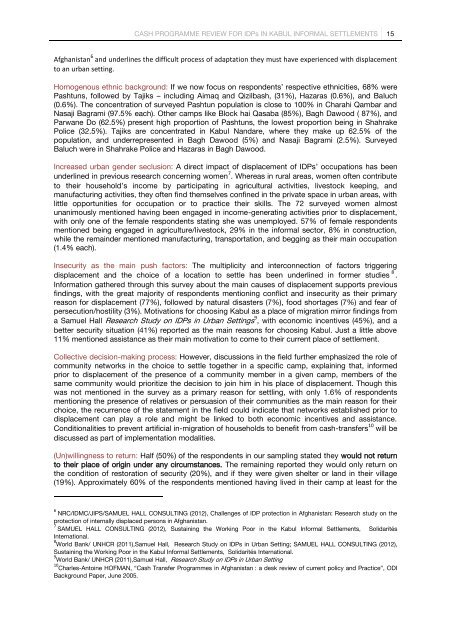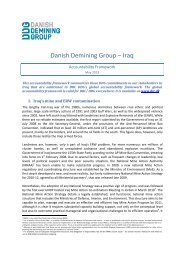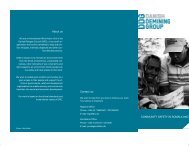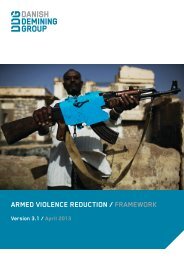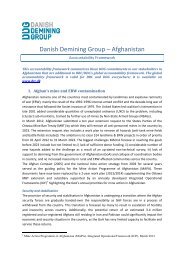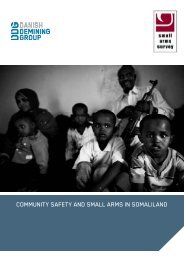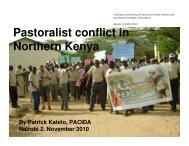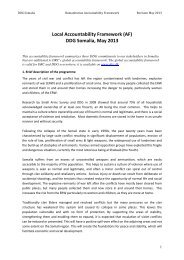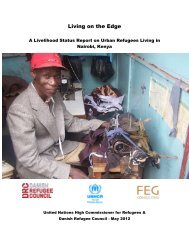Read the full report - Danish Refugee Council
Read the full report - Danish Refugee Council
Read the full report - Danish Refugee Council
Create successful ePaper yourself
Turn your PDF publications into a flip-book with our unique Google optimized e-Paper software.
CASH PROGRAMME REVIEW FOR IDPs IN KABUL INFORMAL SETTLEMENTS 15Afghanistan 6 and underlines <strong>the</strong> difficult process of adaptation <strong>the</strong>y must have experienced with displacementto an urban setting.Homogenous ethnic background: If we now focus on respondents’ respective ethnicities, 68% werePashtuns, followed by Tajiks – including Aimaq and Qizilbash, (31%), Hazaras (0.6%), and Baluch(0.6%). The concentration of surveyed Pashtun population is close to 100% in Charahi Qambar andNasaji Bagrami (97.5% each). O<strong>the</strong>r camps like Block hai Qasaba (85%), Bagh Dawood ( 87%), andParwane Do (62.5%) present high proportion of Pashtuns, <strong>the</strong> lowest proportion being in ShahrakePolice (32.5%). Tajiks are concentrated in Kabul Nandare, where <strong>the</strong>y make up 62.5% of <strong>the</strong>population, and underrepresented in Bagh Dawood (5%) and Nasaji Bagrami (2.5%). SurveyedBaluch were in Shahrake Police and Hazaras in Bagh Dawood.Increased urban gender seclusion: A direct impact of displacement of IDPs’ occupations has beenunderlined in previous research concerning women 7 . Whereas in rural areas, women often contributeto <strong>the</strong>ir household’s income by participating in agricultural activities, livestock keeping, andmanufacturing activities, <strong>the</strong>y often find <strong>the</strong>mselves confined in <strong>the</strong> private space in urban areas, withlittle opportunities for occupation or to practice <strong>the</strong>ir skills. The 72 surveyed women almostunanimously mentioned having been engaged in income-generating activities prior to displacement,with only one of <strong>the</strong> female respondents stating she was unemployed. 57% of female respondentsmentioned being engaged in agriculture/livestock, 29% in <strong>the</strong> informal sector, 8% in construction,while <strong>the</strong> remainder mentioned manufacturing, transportation, and begging as <strong>the</strong>ir main occupation(1.4% each).Insecurity as <strong>the</strong> main push factors: The multiplicity and interconnection of factors triggeringdisplacement and <strong>the</strong> choice of a location to settle has been underlined in former studies 8 .Information ga<strong>the</strong>red through this survey about <strong>the</strong> main causes of displacement supports previousfindings, with <strong>the</strong> great majority of respondents mentioning conflict and insecurity as <strong>the</strong>ir primaryreason for displacement (77%), followed by natural disasters (7%), food shortages (7%) and fear ofpersecution/hostility (3%). Motivations for choosing Kabul as a place of migration mirror findings froma Samuel Hall Research Study on IDPs in Urban Settings 9 , with economic incentives (45%), and abetter security situation (41%) <strong>report</strong>ed as <strong>the</strong> main reasons for choosing Kabul. Just a little above11% mentioned assistance as <strong>the</strong>ir main motivation to come to <strong>the</strong>ir current place of settlement.Collective decision-making process: However, discussions in <strong>the</strong> field fur<strong>the</strong>r emphasized <strong>the</strong> role ofcommunity networks in <strong>the</strong> choice to settle toge<strong>the</strong>r in a specific camp, explaining that, informedprior to displacement of <strong>the</strong> presence of a community member in a given camp, members of <strong>the</strong>same community would prioritize <strong>the</strong> decision to join him in his place of displacement. Though thiswas not mentioned in <strong>the</strong> survey as a primary reason for settling, with only 1.6% of respondentsmentioning <strong>the</strong> presence of relatives or persuasion of <strong>the</strong>ir communities as <strong>the</strong> main reason for <strong>the</strong>irchoice, <strong>the</strong> recurrence of <strong>the</strong> statement in <strong>the</strong> field could indicate that networks established prior todisplacement can play a role and might be linked to both economic incentives and assistance.Conditionalities to prevent artificial in-migration of households to benefit from cash-transfers 10 will bediscussed as part of implementation modalities.(Un)willingness to return: Half (50%) of <strong>the</strong> respondents in our sampling stated <strong>the</strong>y would not returnto <strong>the</strong>ir place of origin under any circumstances. The remaining <strong>report</strong>ed <strong>the</strong>y would only return on<strong>the</strong> condition of restoration of security (20%), and if <strong>the</strong>y were given shelter or land in <strong>the</strong>ir village(19%). Approximately 60% of <strong>the</strong> respondents mentioned having lived in <strong>the</strong>ir camp at least for <strong>the</strong>6 NRC/IDMC/JIPS/SAMUEL HALL CONSULTING (2012), Challenges of IDP protection in Afghanistan: Research study on <strong>the</strong>protection of internally displaced persons in Afghanistan.7 SAMUEL HALL CONSULTING (2012), Sustaining <strong>the</strong> Working Poor in <strong>the</strong> Kabul Informal Settlements, SolidaritésInternational.8 World Bank/ UNHCR (2011),Samuel Hall, Research Study on IDPs in Urban Setting; SAMUEL HALL CONSULTING (2012),Sustaining <strong>the</strong> Working Poor in <strong>the</strong> Kabul Informal Settlements, Solidarités International.9 World Bank/ UNHCR (2011),Samuel Hall, Research Study on IDPs in Urban Setting10 Charles-Antoine HOFMAN, “Cash Transfer Programmes in Afghanistan : a desk review of current policy and Practice”, ODIBackground Paper, June 2005.


